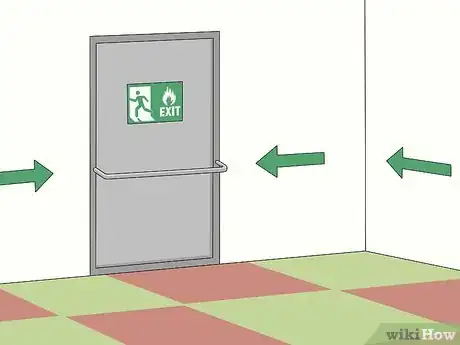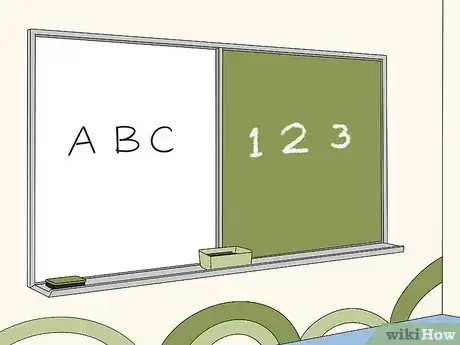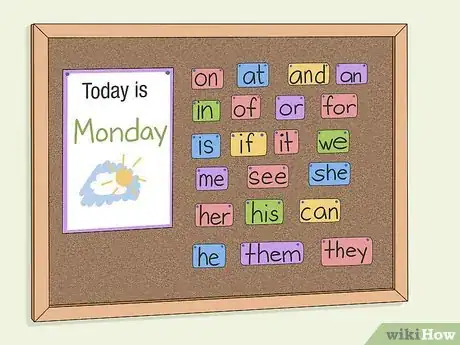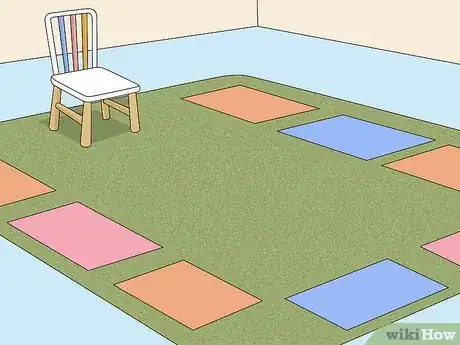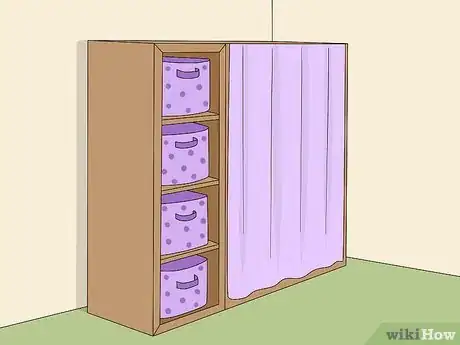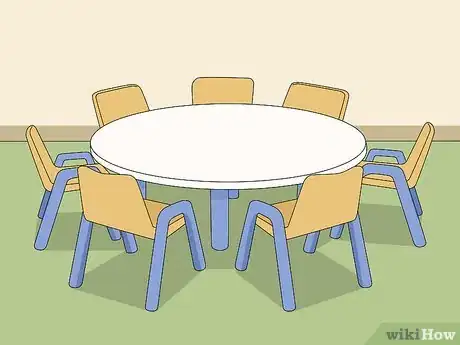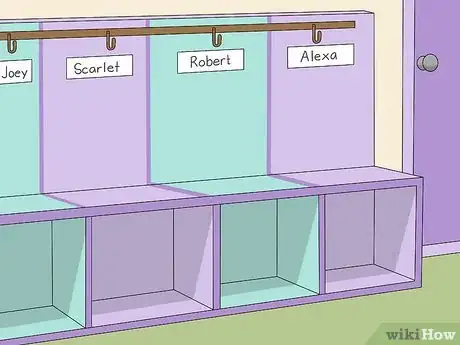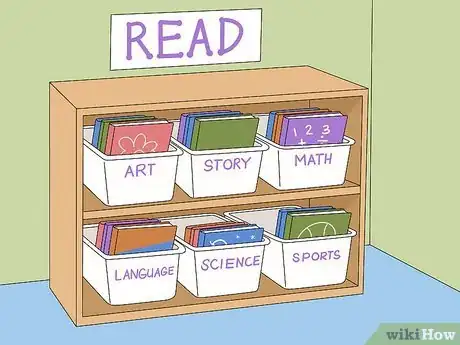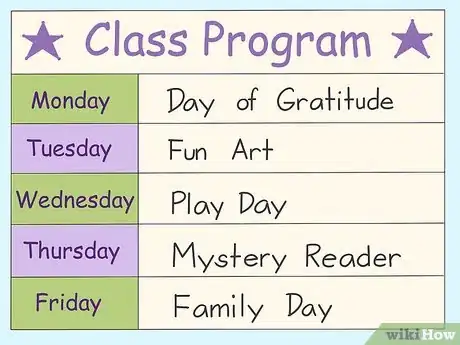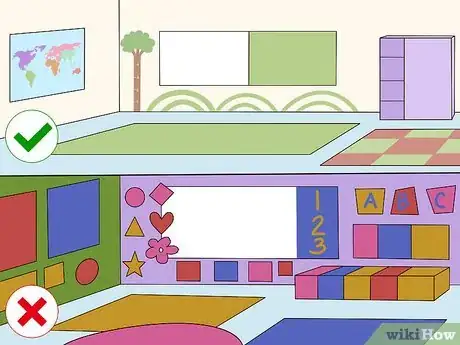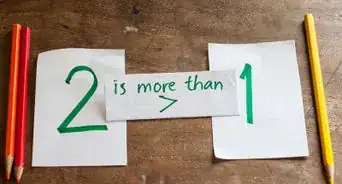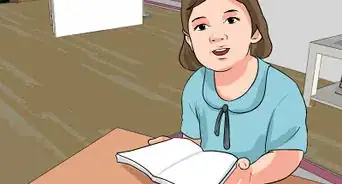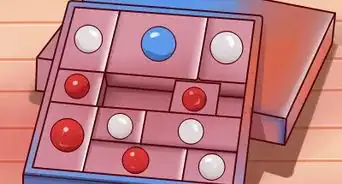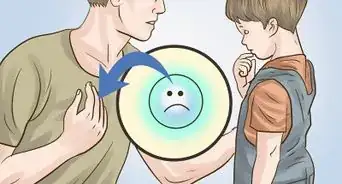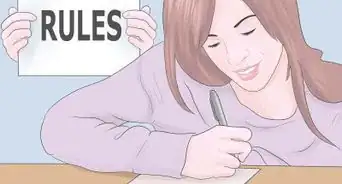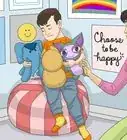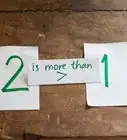X
wikiHow is a “wiki,” similar to Wikipedia, which means that many of our articles are co-written by multiple authors. To create this article, 21 people, some anonymous, worked to edit and improve it over time.
This article has been viewed 205,007 times.
Learn more...
Setting up a safe and playful environment for children ages four to six can be difficult especially if you are a first-time teacher or even coming back from summer again. The trick with setting up the classroom is to make it cute, colorful and efficient while also making it a safe and appealing environment to learn in. Here are some pointers for setting up your classroom.
Steps
-
1Safety first. Kindergarten classrooms foremost have to be a safe place. There are rules, guidelines, and regulations regarding classroom set-ups. These will vary from country to state, to licensing body or accrediting institution. However, some issues to consider are:[1]
- Students are visible at all times. You must be able to monitor the classroom reasonably well. Students who know they cannot be seen will often misbehave.
- Students should not have easy access to hazardous items such as paper cutters, kitchen knives, electrical sockets, or medication. Keep dangerous objects in a locked cupboard, and place child-proof socket protectors over electrical sockets.
- Fire exits must not be blocked, emergency exits should be clearly marked, and fire drills should be carried out regularly. Practice "lockdown" as directed. Kindergarten children tend to be very sensitive to these often unannounced, noisy, sometimes scary drills.
- Make sure materials are appropriate for young students. For example, use non-toxic art materials such as glue sticks, tempera paint, and certified crayons. Materials fine for older students, such as permanent markers should not be used by young children.
-
2Have an area for whiteboard, chalkboard, or SmartBoard. When working with a large group, you are likely to want something to write on or otherwise illustrate a lesson.[2]
- Many people argue that a chalkboard is the go-to method. While time-tested, chalk dust can trigger asthmatic children.
- Whiteboards are increasingly more common. Dry erase markers are now typically odorless and have fewer of the issues of chalkboards.
- SmartBoards are the latest in technology. On it, one can set up multi-media presentations, such as PowerPoint. You can share websites, video, audio, and interactive games. While it takes some training and requires technological support, both teachers and students typically love it.
Advertisement -
3Have a space for important student information. Kindergartens have a wealth of information that has to be organized: what is for lunch, classroom jobs, where students go upon dismissal and more. Not only does this keep the students organized, but the teacher as well. For a substitute teacher, this information is critical. For example:[3]
- Post your daily schedule. Having a daily schedule makes sure everyone knows what happens when. Be sure to include things that are not necessarily everyday things, such as assemblies, field trip departure time, and so on.
- Make lunch and snack choices simple. If you, as a teacher, have to process food orders, have your students take some responsibility. For example, a chart in which a marker (such as a craft stick with his or her name) is placed for the type of lunch, if ordering milk for a snack etc.
- Classroom jobs: A chart with names and jobs helps to make it clear who feeds the class guinea pig and who is line leader.
- Dismissal: A chart with names and dismissal information should be easy to find. Usually, there is a list of buses, walkers, and students going to an after-school program and pick-ups. Note that schedules are sometimes very complicated.
- Calendar: A calendar is helpful for developing a sense of time, and concepts such as weeks and days of the week. It can also help show upcoming or past events, such as holiday breaks, field trips, and birthdays.
- Consider making a word wall. It's easy; just type up some words, and print them out as largely as possible, and post them on the wall so that the children can easily read them.
-
4Have a large meeting area. Typically, kindergarten children need a large open area to gather for lessons, to play, and sometimes for taking a nap. Many teachers have colorful individual rug tiles, a single low table in the middle, or a large rug that delineates the meeting area.[4]
- Many teachers like having a "teacher chair" in this area. This is a chair that is adult-sized and acts as a focal point for meeting time. Having an elevated sitting spot allows the teacher to be more easily seen while reading a story book or teaching a lesson. Older teachers, especially try to avoid sitting on the floor (and the subsequent getting up) too often.
- A soft armchair is a warm, soft, homey touch in what can be a sea of hard, institutional furniture. However, upholstered chairs can be an allergy issue (especially since these chairs tend to be old and thus a bit dusty) for some children.
- Rocking chairs are an injury hazard, even though rocking is soothing for children. Consider a "glider" chair instead. Be aware that kids with impulse control issues may misuse these chairs.
- Do not use a swivel chair, or one on coasters unless perhaps these functions are disarmed. Young children will spin on them and roll them around for fun and thus become a hazard and at the very least a huge distraction.
- Many teachers like having a "teacher chair" in this area. This is a chair that is adult-sized and acts as a focal point for meeting time. Having an elevated sitting spot allows the teacher to be more easily seen while reading a story book or teaching a lesson. Older teachers, especially try to avoid sitting on the floor (and the subsequent getting up) too often.
-
5Be sure materials adjacent to the meeting area are not overly distracting. The meeting area should be kept free of too many distractions, obstacles, or clutter.[5]
- Consider fabric coverings over shelving to block the view of students. For some students, seeing toys is a distraction.
- Be sure there is enough room between other areas and the meeting area. If students are squished against a bookcase, for example, it is an annoyance and distraction. Also, wriggly children will tend to knock things over.
-
6Have a work area. Give assigned seats, and rather than desks, give a homey appeal and give tables. They should be circular or blunt edged rectangular to avoid sharp corners. There should be enough chairs for everyone and a couple extras; metal is preferred rather than wood to avoid multiple replacements,[6]
- Tables, desks and chairs should fit students properly. Furniture should mostly be child-sized. A good janitor or custodian can adjust some furniture down (such as tables) to fit.
- Desks or tables? Both have pros and cons.
- Generally, tables are preferred by early childhood professionals to encourage a sense of community rather than individual territory. Also, young children tend to not be able to manage materials in desks. Of course, sometimes you do not have a choice and make do with what you have.
- Desks have the advantage of giving an excellent sense of personal space.
- If a room is especially spacious, a combination of desks and tables allows for versatility. For example, perhaps worksheets are best done at individual desks, but a hands-on science experiment is done at a large table so everyone can see.
- Give a source of writing equipment; put cups on tables for either markers or pencils, whichever you prefer their using on a particular assignment (pencil is favored for daily work).
-
7A place for children's belongings. Kindergarten students need a clear, simple organization system for belongings. It needs to be adequate to keep personal belongings such as lunchboxes and backpacks and hang up coats, snowsuits, and so on.[7]
- Inside the classroom or in the hallway? Inside the classroom avoids having students leaving the classroom, where it is harder to monitor them. However, inside the classroom needs more room (which may be in short supply), and tempts children to constantly go to and from cubbies and so on, which may be a distraction.
- Lockers are generally not good for kindergartners. They tend to try to hide in them or play dangerously with the doors. Cubbies are typically better.
- Each child should have their own labeled coat-hook in order to avoid confusion. In cold climates, two may be necessary to hang up backpacks, bulky winter coats, and snow pants. #*Have your own space as a teacher. You should have your own desk and computer in the classroom, which you should be sure the children do not have easy access to. While you should not have anything truly dangerous in your work area, you need to have your own space for your work as a teacher. This includes student information, emergency kits, substitute plans, "teacher scissors", and so on.
-
8Carefully consider wall space. Apart from chalkboards and such, kindergarten walls typically are full of both informational displays and student work. But this space typically fills up quite quickly, and what to put up should be considered with great care.[8]
- Informational displays. This includes things such as alphabets, "Word Walls", classroom rules, classroom jobs, maps, posters, and so on. Be sure the information is useful, makes sense where it is, tidy, and aesthetically pleasing.
- Student work. Displaying the hard work of the students is a powerful message that their work matters and is valued. Be sure all students have items put on the bulletin board, not just the best or most artistic.
- Art or other Beautiful Things. Sometimes teachers proudly display something mostly just for beauty, inspiration, or for its own sake.
- Be careful of cluttered walls. A more detailed explanation is below.
-
9Create a classroom library. Books are a central focus of the classroom. Organization is extremely important, as it needs to be accessible, easy for children to re-shelve, and pertinent to the curriculum.[9]
- It is usually better to have several smaller shelves or sections than one large "shelf" that tends have books tumbling over.
- Try organizing around categories so children can narrow down what they want to read: "Animals", "Eric Carle Books", "Sports Books", "Science Books", "Fairy Tales".
- Have books out that are topics of the curriculum. If you are studying penguins, have books out about Arctic creatures.
- Audit your books for diversity and inclusion. Are the majority of your main characters male? Are there any books with characters with disabilities? Are there characters that reflect your minority community? Do you have books that both reflect your community, but also others different than yours?
- Have a comfortable reading environment. Try to make your library area cozy and inviting to read in. Make sure the lighting is good, that there is space to sit down or lie down comfortably, and there are limited distractions.
- Make sure that your classroom is restocked with what you will need; such as paper towels, tissues, hand sanitizer, etc. Ask parents for generous donations; many are willing to help out! Some schools, school districts or the parent-teacher organization (PTO/PTA) will furnish such things.
-
10Design your class programs. Some schools have "mystery reader," where a parent comes in and reads to the class, as their child beams with joy, or parent helps with choice time, where their child gets to choose whether they'd like to color, play a game, etc. Whichever you choose, you should be able to do it in your perfectly set-up kindergarten classroom.
-
11Avoid common beginner mistakes. When putting together a kindergarten classroom, there are some very common mistakes new teachers make.
- Limit the number of posters. You may want to put up lots of things: "word walls," maps, calendars, birthday charts, inspirational posters, art, and more. But too much clutter can be distracting, especially for students with disabilities like autism or sensory processing disorder. Only put up the most important things.
- Limit bright colors. Vivid colors can be overwhelming to kids, especially those with disabilities. Try soft whites or pastels for the walls and most of your space, with a few "pops" of color.
- Do not rely too much on word labels for bins and boxes. Not all kindergarten students can read basic words yet. Some students may speak a different language, have learning disabilities like dyslexia, or not know how to read yet. In any case, young children take longer to process writing than adults, and so these labels might be confusing.
- Put photos or cartoons on labels along with words.
- Encourage students to help you make labels. It helps with writing skills, classroom cooperation, and fine motor skills.
Advertisement
Community Q&A
-
QuestionI want to open a preschool. How can I get started?Get in contact with your region's educational department. There are typically regulations and paperwork to fill out, and resources to help you figure out how to get started.
-
QuestionHow do I begin teaching my kindergartner at home as if it were a classroom?As a homeschooler, you need to determine what elements of kindergarten you want to include in your curriculum. There is no one type of kindergarten. Typically kindergarten stresses academic and social readiness. You work up to what is expected in 1st grade.
-
QuestionHow can I entertain my kindergarten students?
 Community AnswerHave time period set aside to play a game with the kids. Simon Says is a good one to get energy levels up, and a math or thinking game gets their brains working.
Community AnswerHave time period set aside to play a game with the kids. Simon Says is a good one to get energy levels up, and a math or thinking game gets their brains working.
Advertisement
Warnings
- Make sure you have the essentials for a Kindergarten class: first aid kit, phone to call the office, nurse or police, an Epi-Pen, a fire extinguisher, and know who is certified in the Heimlich Maneuver and CPR. Know procedures for special needs such as hypoglycemia, diabetes, mainstreamed special ed students in the regular classroom, etc.⧼thumbs_response⧽
- You should know the procedures and codes for fire and storm alarms (and lock-downs where everyone locks doors and stays clear of them and the windows, as best they can).⧼thumbs_response⧽
Advertisement
References
- ↑ https://www.educationworld.com/a_curr/creating-safe-classroom-environment-climate.shtml
- ↑ https://www.responsiveclassroom.org/sites/default/files/ETKch1.pdf
- ↑ https://www.responsiveclassroom.org/sites/default/files/ETKch1.pdf
- ↑ https://www.edutopia.org/blog/7-learning-zones-classroom-veronica-lopez
- ↑ https://www.nbcnews.com/news/education/bare-walls-theory-do-too-many-classroom-decorations-harm-learning-n223436
- ↑ https://www.edutopia.org/blog/7-learning-zones-classroom-veronica-lopez
- ↑ https://www.edutopia.org/blog/7-learning-zones-classroom-veronica-lopez
- ↑ https://www.nbcnews.com/news/education/bare-walls-theory-do-too-many-classroom-decorations-harm-learning-n223436
- ↑ https://www.readingrockets.org/article/creating-classroom-library
About This Article
Advertisement
